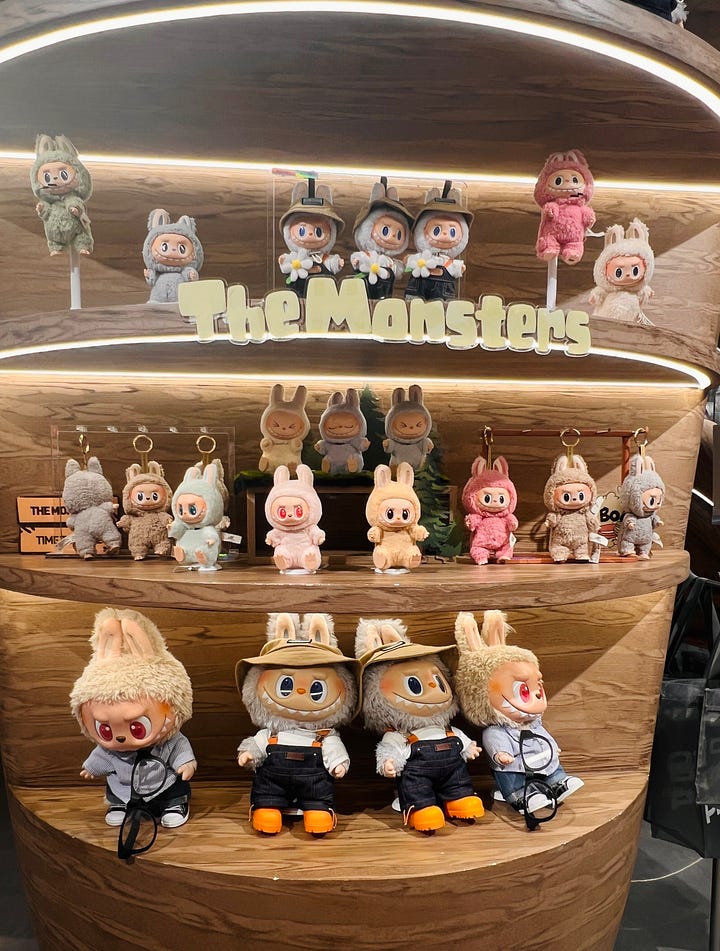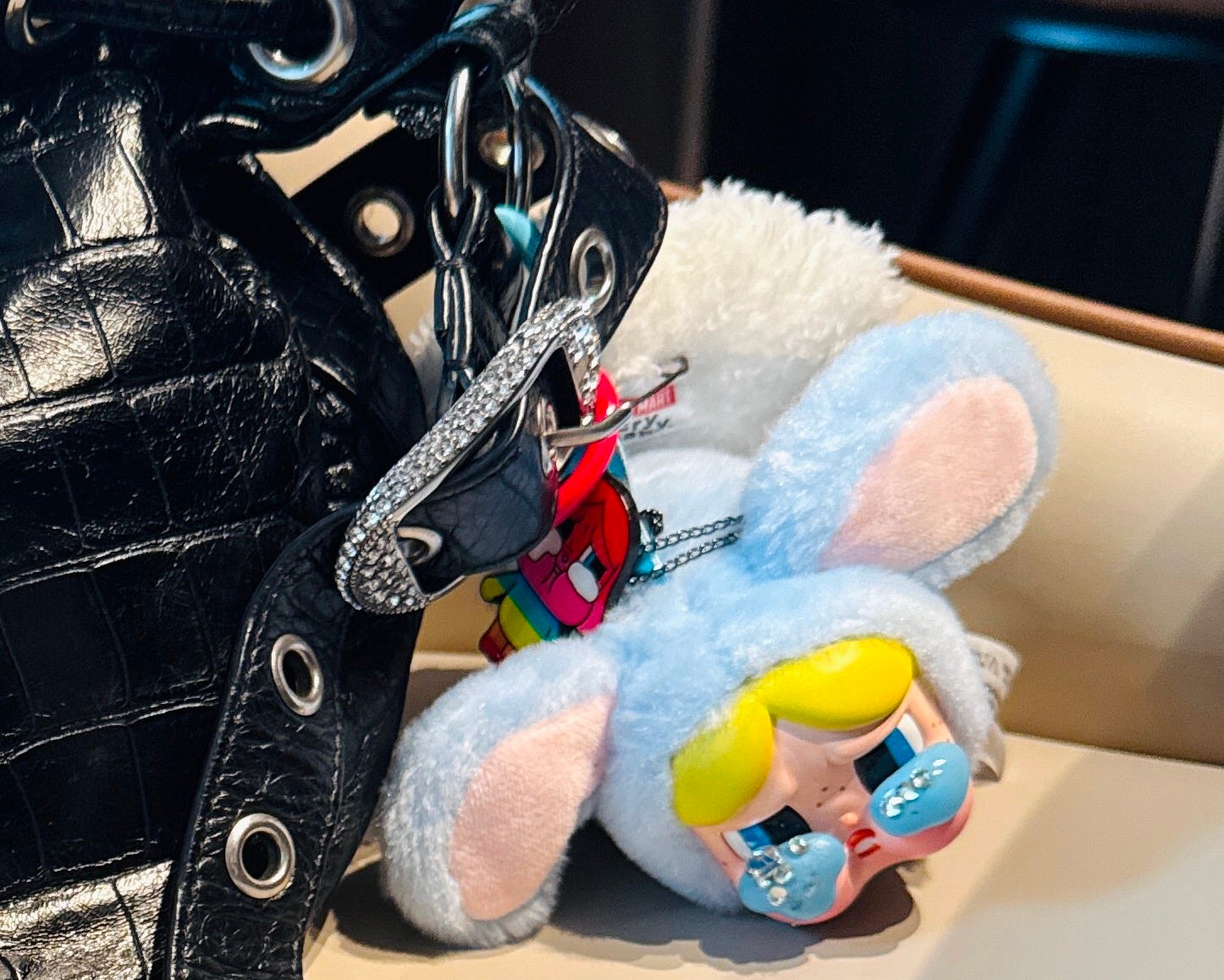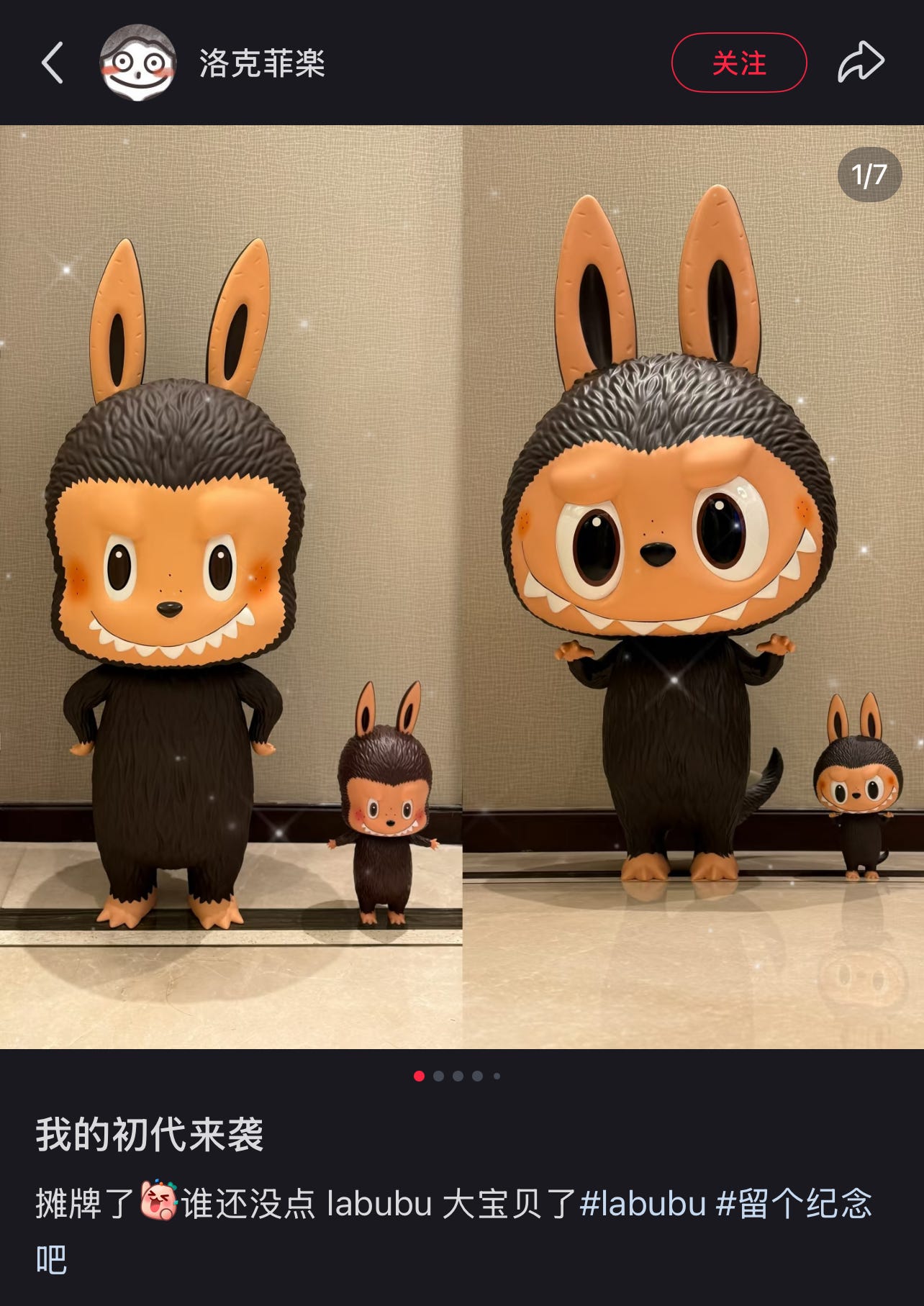Labubu and the Rise of Emotional Capitalism in Downturn-Era China
Reader, I became a Pop Mart convert to write this piece
Recently on Rednote, a trending topic—#经济上行时期的美 ("What does beauty look like during an economic upswing")—has been popping up in my feed. Scrolling through, one finds the answer: bold colors, confident exploration, and a sense of the future brimming with possibilities. It’s a kind of vibrant, self-assured optimism that defined China in the first two decades of the 2000s.
But what do consumption and standards look like during an economic downturn?
Labubu might be the answer.
I’ve been back in China for about a month and found myself repeatedly drawn to Pop Mart stores. Across the cities I’ve visited—Beijing, Shanghai, Chengdu, Suzhou, Wuhan—I walked into at least half a dozen locations. For research, I told myself.
No matter the city, Pop Mart stores had shoppers, unlike many of their retail peers. At Wuhan’s SKP mall, nearly empty on a weekday evening, the only store with customers and purchasing happening was Pop Mart on the B1 level.
There’s plenty to look at and plenty to buy. But the most sought-after IPs are always sold out. Every time I ask, “Do you have any Labubus?” I’m met with a look that suggests I’ve asked the most naïve question imaginable. Yet Labubus are everywhere—either tethered, housed in clear plastic boxes, or featured as store decorations. Shoppers can see them, touch them, squeeze them, admire them—but they can’t own them.
What’s on display is the unattainable, and that makes it all the more tantalizing.


I never left a Pop Mart store empty-handed. I needed a consolation prize for the disappointment of not securing the prized Labubu or Cry Baby. So I’d settle for a Cry Baby–themed charging cable blind box or a Labubu-shaped candle. At least those are useful, I justified in my head.
In China, there’s a word that keeps surfacing in conversations about the unexplainable: 抽象, often translated as "abstract." In Chinese internet slang, though, it has taken on a different life. It’s a catch-all term for things that don’t make sense on the surface—bizarre, absurd, inexplicable—but still resonate on an emotional or aesthetic level. It suggests a kind of unbothered calm, paired with a desire to stand out. Beneath it runs an undercurrent of apathy, even nonchalance, toward the things people feel they cannot change—a hopelessness wrapped in a sense of “whatever.” I define 抽象 as a way of rationalizing behaviors that defy logic. It reflects both a need for self-expression and a recognition of powerlessness at the same time.
Like the fact that it’s nearly impossible to get your hands on a Labubu. Or that people dress up as Zimomo mascots and dance in restaurants in hopes of chasing traffic and shares. Or the collective wave of nostalgia for a past that seems to promise the psychological safety we all crave.
*The Zimomo dance below happened at a family dinner outing in Wuhan. There is a Part II where Zimomo cajoled my tweenager son to dance with him, but I do not have permission to share publicly.
In Beijing, a friend gave me Cry Baby X Powerpuff Girls. We even decorated its “tears” with stick-on crystals from her leftover stash from last year’s Tomorrowland trip. It now dangles from my patent leather Balenciaga. Just like how I got my first Labubu (you can read about it on Care to Elaborate), the act of generosity felt meaningful—like I’d been honored with a treasure. She gave up her Cry Baby for me. And somehow, that meant I mattered more than the doll. It felt a little absurd, and strangely tender. I leaned into the designer bag and Pop Mart trend and felt like I’d joined a moment. Very 抽象.
China Consumption Observed
Compared to last year, China’s vibes felt noticeably more subdued. Not because conditions had objectively improved, but because a quiet sense of resignation had taken hold. There was a kind of “Who is John Galt?” energy—an acceptance of the status quo and a tapering of the relentless drive I have always associated China with. Perhaps it was also because people had found new outlets. Go see a concert by your favorite Chinese artist from your youth. Take a short trip and take all the photos to show for it. Collect Labubus. Savor the thrill of slicing open Pop Mart’s blind box packaging.
A form of collective coping, perhaps?
Many of Pop Mart’s most popular IPs express rather than resolve emotions that linger beneath the surface. Molly has this blank emotional expression. Labubu’s mischievous grin, Hirono’s defiant loneliness, and SkullPanda’s subculture aesthetics all distill complex emotions into simplified, collectible forms. What people are buying through Pop Mart is emotional resonance. Each collector can imbue the toys with their own mood or story.
It’s easy to see why Pop Mart shoppers often say, “This character feels like me.”
The frenzy surrounding Pop Mart and Labubu reflects a deeper shift in Chinese consumerism. Just like income peaks, consumption peaks are shaped by expectations. When people feel optimistic about their future earnings, they tend to spend in advance. But when that optimism fades—especially among 20- to 29-year-olds—spending patterns adjust. In a climate where the floor feels unstable and the ceiling increasingly out of reach, where marginal effort brings diminishing returns, consumers are voting with their wallets. Over the past three years, strolling in parks rose by 226%, followed by city walks at 218%. Meanwhile, karaoke, nightclubs, bars, and shopping all declined.
This is where Pop Mart fundamentally differs from brands like Miniso or Sanrio. Miniso treats IP as business—licensing familiar characters, including many from Sanrio, to sell practical, everyday items. From handheld fans to makeup puffs, its products are designed to be used. Pop Mart’s core products, by contrast, are not functional. Trendy toys, or chaowan 潮玩, are made to be admired, not used. They serve no practical purpose. Chinese consumers are gravitating toward short-term, emotionally gratifying purchases, rather than long-term financial commitments like buying a house or car. Pop Mart offers precisely that—an instant hit of dopamine without the weight of permanence.
Cute sells. It always has. Sanrio, the Japanese company behind Hello Kitty and Kuromi, built a real business on cuteness, delivering a 646% return to investors since 1982, including share price gains and dividends. Pop Mart, by comparison, has returned 488% to date.
How Pop Mart Works
What underpins the Pop Mart economy is a sophisticated operating system.
Pop Mart isn’t just a retailer or toy manufacturer. It operates more like a media company—one that trades in narrative, distribution, and platform value. Creativity may not be monopolized, but Pop Mart has built a system that can simulate, iterate, and optimize the elements that make an IP successful, and do so at scale.
Most of its 90-plus IPs are exclusive, developed through deep collaborations with artists. The power dynamic may shift depending on the popularity of each IP, but what remains constant is the infrastructure Pop Mart provides. Designs and product assortments are continuously tested and refined—across physical stores, resale platforms, social media, and its loyal fanbase. Every time I check out at a Pop Mart store, I’m prompted to join the “community” via my Alipay and asked at the cashier.
The real foundation of Pop Mart’s valuation isn’t just a few breakout characters. It lies in the entire retail and storytelling ecosystem the company has built, where IP functions both as product and as platform. This is a factory of feeling—engineered to produce emotionally resonant characters and to monetize their narratives across every possible channel. Pop Mart even has its own magazine, play/GROUND. Pop Mart livestreams on Rednote and Taobao. You still can’t simply buy a Labubu, but you can try your luck — inventory is released at random
Still, even a well-calibrated machine has its limits—especially when it begins shaping consumer behavior as much as it responds to it. Daigous—who once dealt in luxury handbags by arbitraging price differences across regions—have pivoted to Labubu collectibles, hunting down collection boxes and hard-to-get Labubus. In June, a Chinese bank offered Labubu blind boxes to incentivize fixed deposit signups. The backlash was swift.
The Chinese government has also made its position clear. People’s Daily ran an editorial titled “Blind Cards and Blind Boxes Can’t Be Left Unchecked,” warning of the psychological impact on minors and unchecked commercialism. While People’s Daily did not identify Pop Mart by name, the stock took a hit.
Pop Mart has faced this kind of scrutiny before. In 2022 its market cap sank below HK$15 billion, compared to a market capitalization of around HK$100 billion at its IPO in 2020. Regulatory scrutiny of Pop Mart escalated as Chinese authorities and state media highlighted the “gambling-like” nature of blind box toys, especially their impact on minors, leading to calls for tighter regulations and increased stock market uncertainty. At the same time, consumer enthusiasm waned, with growing negative feedback on social media regarding product quality and pricing, signaling emerging fatigue in the market. After rebounding in 2023, the real question is no longer just about regulation, but whether Pop Mart can replicate past successes like Molly or now Labubu. How will it diversify beyond the toy collectible space—into accessories, lifestyle products, or new categories—to broaden its reach and increase consumer stickiness?
Pop Mart’s success has always hinged on capturing and commercializing the emotional pulse of a generation. You never know what you’ll get—and it’s that uncertainty that fuels repetition. Buy again. Try again. Feel again. But that same loop is also what makes regulation tricky.
The ultimate question facing Pop Mart is whether it can preserve the scarcity-driven thrill while avoiding the tipping point into excess. Emotional capitalism may be an engine of growth, but it is also a delicate machine—one increasingly subject to volatility, scrutiny, and cultural pushback.
The more fluent Pop Mart becomes at orchestrating desire, the more it will be held accountable for the emotional consequences it helps manufacture.








Fascinating. I've never visited China but this article has helped me understand modern day China better than most I've read.
Nihilism sure flies off the shelves!